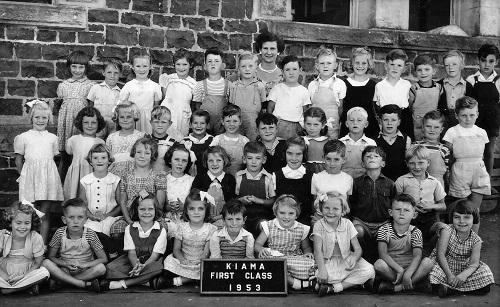Schooling in the Kiama district
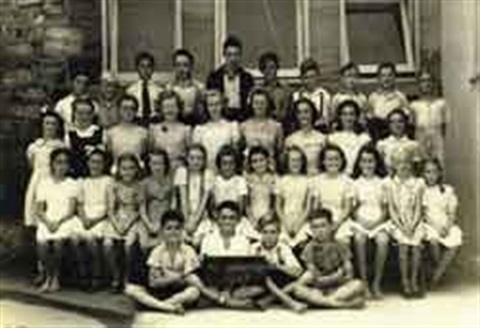
The very first school opened in the Kiama District was in 1839 when Daniel Shea opened a Roman Catholic School in Jamberoo. This was soon followed in 1842 by the Church of England (also in Jamberoo) who erected a weatherboard and shingle roof building which served as both school and church. In that same year, the Presbyterian Church also opened a school in the Jamberoo village.
Meanwhile, it wasn’t until 1843 that Kiama saw its first school when the Church of England opened an Anglican School. This was followed by the Wesleyans who built a church on the north-east corner of Manning and Bong Bong Streets, a building that served as both church and school.
Somewhere between 1848 and 1850, a one roomed school near Spring Hill (between Jamberoo and Kiama) was established and one of its pupils, C. W. Craig, went on to become a mayor of Kiama.
The 1850’s saw the opening of several schools and sometime during this decade, Foxground Anglican School was established and at ‘Rosebank’ Miss Hindmarsh’s School for Young Ladies was started. In ‘Terragong’ Street, Kiama, just north-west of Collins Street, James Hustler and his wife ran a private school.
As early as 1857, efforts began to establish a national school in Kiama. Public meetings were held and were attended by leading citizens, despite opposition by the Reverends associated with the local Anglican school.
On Mt Pleasant, a property just south of Kiama, a small school was opened in 1858 in a small building at the top of the property. The area where the school was located was referred to as ‘Hurricane Hill'. Eliza Davies was the teacher and apparently the school only ran for two years.
The first National school to be opened in the area was at Jerrara in 1858. This school, which was called Jamberoo School until 1875, had one school room, one classroom and two living rooms for its single teacher and 100 pupils. William Cullen, a former pupil of Jerrara went on to become Chief Justice and Lieutenant-Governor of NSW.
It wasn’t until 1859 that children living in Gerringong were able to avail themselves of an education when the Anglican Church opened a school in the village.
More schools continued to be established during the early years of settlement to meet the needs of a rapidly growing population. One hundred and fifty years ago you walked to school and you walked home, no matter what the weather, so schools needed to be close to their pupils.
In 1860, Mt Pleasant School which had previously closed, reopened and then closed again later that year – this time “in all probability for ever". In that same year Foxground School and Gerringong Church of England School had teachers officially appointed by the community. Also in 1860 Omega Retreat, south of Kiama, opened as a public school and on 24th August 1868, the school was favoured by a visit from Henry Parkes during his journey from Gerringong to Kiama.
A local meeting in 1861 sought the establishment of a national school in Kiama with the retention of Mr. Hustler as the teacher and his building as the official school site. A subscription list was opened and Captain Charles along with Mr Robb, Mr McDonald, Mr Hindmarsh and Mr Poulton were appointed local patrons. The school was opened in May 1861 in an old weatherboard building, once a store and later a stable and Mr. James Hustler and his wife were teachers in that first year. For reasons that are unclear, the national school was closed several times in the early years.
In 1862 the national school was examined and subsequently a decision was made to secure a more permanent national school building.
In 1866 a Council of Education had been established to rationalise the provision of schools in the whole Colony. It was decided that Kiama would commit to the state run Council of Education program and seek grants for a building site.
Meanwhile the national school and Church of England denominational school continued to operate whilst subscription lists for money to build the national school circulated throughout the district. However the goal of a permanent building was not achieved for several years and it was not until 1870 that tenders for the erection of a school were sought. The public school of stone was opened on 5th April, 1871 with J G Stewart being appointed as its first teacher. Construction costs were met jointly by locals and the Council of Education, one third of the £1123 being paid by Kiama residents and two thirds by the Council of Education.
Another school, which was eventually called Minnamurra School, began in 1862 at Peterborough on George Fuller’s Dunmore property and in 1881 a more permanent school building made of basalt was erected on Swamp Road. This school was closed in 1907 and the building stands derelict today.
Further south, the Catholic School in Gerringong opened in 1864 and when Rose Valley Public School opened in 1868, Fred King was appointed as teacher.
Private or church run schools continued to flourish in the late 1800’s and in 1870 Druwalla and Wallaby Hill schools opened in the Jamberoo area. Druwalla (or possibly Druewalla) School seems to have replaced Osborne Hill School which was further up Jamberoo Mountain. Other schools attended by Jamberoo children were Stockyard and Croome. The Wallaby Hill School was later moved down to Jamberoo village into premises which later became the blacksmith’s paint shop.
In 1871 both Toolijooa School and Kiama Public School opened and by 1872 Kiama Public had an enrolment of 205. The following year saw the establishment of schools at Mt Brandon (at the foot of Saddleback Mountain) and Woodstock (which was commonly called Jamberoo).
The Church of England Denominational School at Kiama closed in 1872 but in the same year Jamberoo sought to open a public school in the former Man of Kent Inn – premises which had also been used as the Woodstock Stores.
In August 1873 a public meeting in Gerringong was held to discuss the establishment of a public school. However there was some opposition from
R. Miller (Mayor) and Mr Hunt who was the headmaster at Omega Retreat School. In any event, the Council of Education refused the request as it was felt the education available in the area was adequate. Further requests followed and finally permission and Government support for a public school was granted in 1874.
Also in 1874 it was decided to establish a permanent public school in Jamberoo. Fortunately for Jamberoo, in 1875, the Colonial government announced that it would meet all costs of erecting school buildings and in that same year, John Tate of Tate’s Hill, made a site available for the construction of the public school.

Meanwhile Gerringong Public school began operation in March 1876.
The opening of Jamberoo Public school in 1878 saw the closure of the Woodstock School and the Jamberoo Anglican School.
However a new school had opened in 1872 at Mt Brandon near Saddleback Mountain but closed in 1891. Mt Brandon school reopened in 1897, closed in 1907, reopened as a half time school in 1908 and finally closed permanently in 1911.
In 1880 The Public Instruction Act made school attendance in NSW compulsory for all children aged between 6 and 13. Also that same year, school fees in NSW were drastically reduced and eventually in 1906 were completely abolished.
As public schools became more popular and of course transport a little easier, many private schools closed. In1887Jamberoo Catholic School closed, Bombo Public School opened in 1890 and closed in 1948, Rose Valley school closed in 1904, followed by Omega Retreat School in 1941, Foxground School in 1950 and Toolijooa in 1951.
Schooling in the Kiama District Timeline
1839 - Daniel Shea opened a Roman Catholic school in Jamberoo
1842 - Church of England school and Presbyterian school opened in Jamberoo. A Church of England school was established in Kiama
1848 - The Governor, Sir Charles Fitzroy established the National Board of Education, starting public education in NSW. Under this system the Board would pay 2/3 of the cost of erecting and fitting out a school, when the attendance could be guaranteed to be at least 30 pupils. The local community was required to raise 1/3 and take part in the management of the school
1848 or 1850 - a one roomed school near Spring Hill (between Jamberoo and Kiama, where road meets Riversdale Rd was established. C. W. Craig (Kiama Mayor) attended this school.
1850 - Foxground Anglican School established
1857 - Efforts began to establish a national school in Kiama, with public meetings attended by leading citizens, despite opposition by the reverends associated with the Anglican school.
1858 - Mt Pleasant School, small building at the top of the property, referred to as ‘Hurricane Hill". Eliza Davies was the teacher. The school ran for two years.
1858 -Jerrara National School was established. This school had one school room, one classroom and two living rooms for the teacher and 100 pupils. Jerrara School was called Jamberoo School until 1875. William Cullen, a former pupil of Jerrara went on to become Chief Justice and Lieutenant-Governor of NSW.
1858 - Subscription fund was opened to erect a national school in Kiama in May 1858, the government granted the site in June, but the erection of the school didn’t take place for some years.
1859 - Anglican School established in Gerringong
1850’s – Establishment of Miss Hindmarsh’s school for young ladies at ‘Rosebank’, and Hustler’s private school in ‘Terragong St’, Kiama.
1860 - Omega Retreat School opened, Mt Pleasant School reopened and then closed again later that year. Foxground School had a teacher appointed.
1861 – A local meeting sought the establishment of a national school in Kiama and the retention of Mr. Hustler and his building. A subscription list was opened and Captain Charles along with Mr Robb, Mr McDonald, Mr Hindmarsh and Mr Poulton were appointed local patrons. The school was opened in May 1861 in an old weatherboard building, once a store and later a stable. Mr. James Hustler and his wife were teachers in the first year.
The national school closed several times in the early years.
1862 - National school was examined and subsequently a decision to get a national school building vested in the Council of Education, however this was not secured for several years.
1862 - Petersborough Public School (name changed to Minnamurra in 1886) began on Fuller’s Dunmore property
1864 - Gerringong Catholic School opened.
186 5- building lots on Minnamurra St, Kiama were granted as a school site.
1866 - Council of education established to rationalise the provision of schools in the Colony. Government grants wouldn’t be given for denominational schools that were too close to existing public schools.
1868 - Rose Valley Public school opened
1870 – Tender out for the construction of the Kiama Public School building. 1/3 was paid by the Kiama residents and 2/3 by the Council of Education.
1870- Druwalla and Wallaby Hill schools opened. Druwalla School seems to have replaced Osborne Hill School (closed in 1895) which was further up Jamberoo Mountain, for many Jamberoo children. Other schools attended by Jamberoo children were Stockyard and Croome. The Wallaby Hill School was later moved down to Jamberoo village and became the blacksmith’s paint shop.
1871- Toolijooa School opened
1871- Kiama Public school opened in April, and had an enrolment of 205 in 1872
1872 - Mt Brandon and Woodstock established schools. The Woodstock school operated in the former ‘Man of Kent Inn.
1872 - Church of England Denominational Schoo closes
1873- 4th August 1873 a public meeting at Boat harbour to establish a public school-however there was some opposition from R. Miller (mayor) and Mr Hunt who was the headmaster at Omega Retreat School. The Council of Education refused the request as it was felt the education available in the hour was adequate. Further requests meant that permission and Government support for a public school was granted in 1874.
1874 - Decision to establish a public school in Jamberoo, midway between Woodstock school and the Anglican school.
1875 - Announced that the Colonial government would meet all the costs of erecting school buildings (p.74)
1875 – the site for the public school at Jamberoo was made available by John Tate on Tate’s Hill.
1876 - Gerringong Public school began operation in March 1876.
1878 - opening of Jamberoo Public school on Tate’s Hill and closure of the Woodstock School and the Jamberoo Anglican School. A teacher from the NSW North Coast was appointed, Mr George Thornton, despite separate groups trying to get both the Anglican teacher and the Woodstock teacher appointed.
1880 - Public Instruction Act made school attendance compulsory for all children aged between 6 and 13. Children were obliged to attend 70 days of schooling each 6 months (or 3 days a week). With the introduction of the Public Instruction Act 1880, the school fees were reduced from sixpence per child per week to threepence per child or a maximum of 1 shilling per family. Many small schools opened in response to this as children couldn’t all travel into the village schools.
1881 -Dunmore School built of basalt erected on Swamp Road. This school closed in 1907.
1887 - Jamberoo Catholic School closed
1904 - Rose Valley school closed
1906 - All school fees for primary schools in NSW were abolished
1941 - Omega Retreat School closed
1950 - Foxground school closed
1951 - Toolijooa school closed
Government Schools in the Kiama District


An image gallery of the district school photos & the school buildings is available
References:
Jamberoo: A happy valley
A prelude to the history of Jamberoo
Jamberoo Public School 1878-2003.
Bluehaven by William Bayley
Gerringong and District: A History by John Shortis
Kiama Primary School Centenary 1861-1961
Gerringong Public School Centenary 1876-1976
The old school farewell: Gerringong 1994.
A pictorial history of Kiama Public School 1988.
Kiama School, Minnamurra St, Kiama. The school was built out of the local basalt in 1871. c.1920's
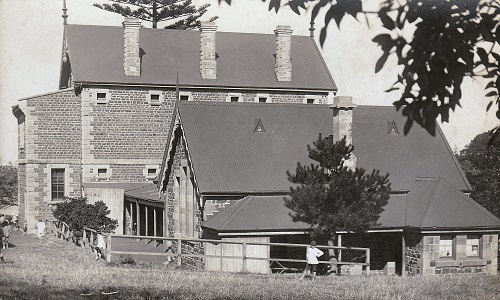
Gerringong Public School 1966.
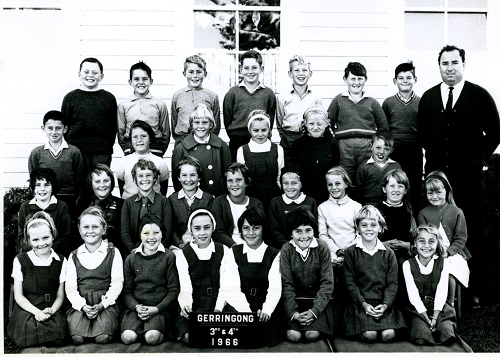
Originally known as Jamberoo School from 1858-1875. From 1875-1950 the school was known as "Jerrara School"
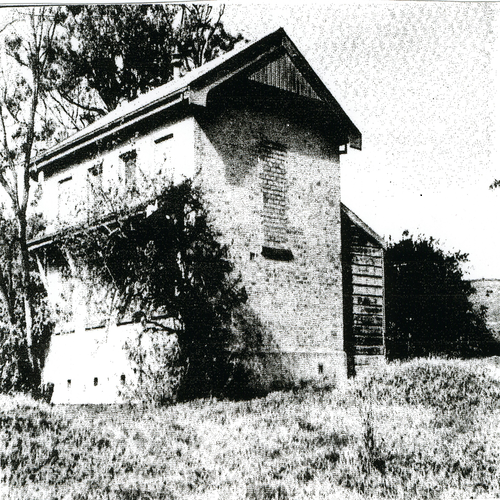
1953 Kiama Public School 1st class.
